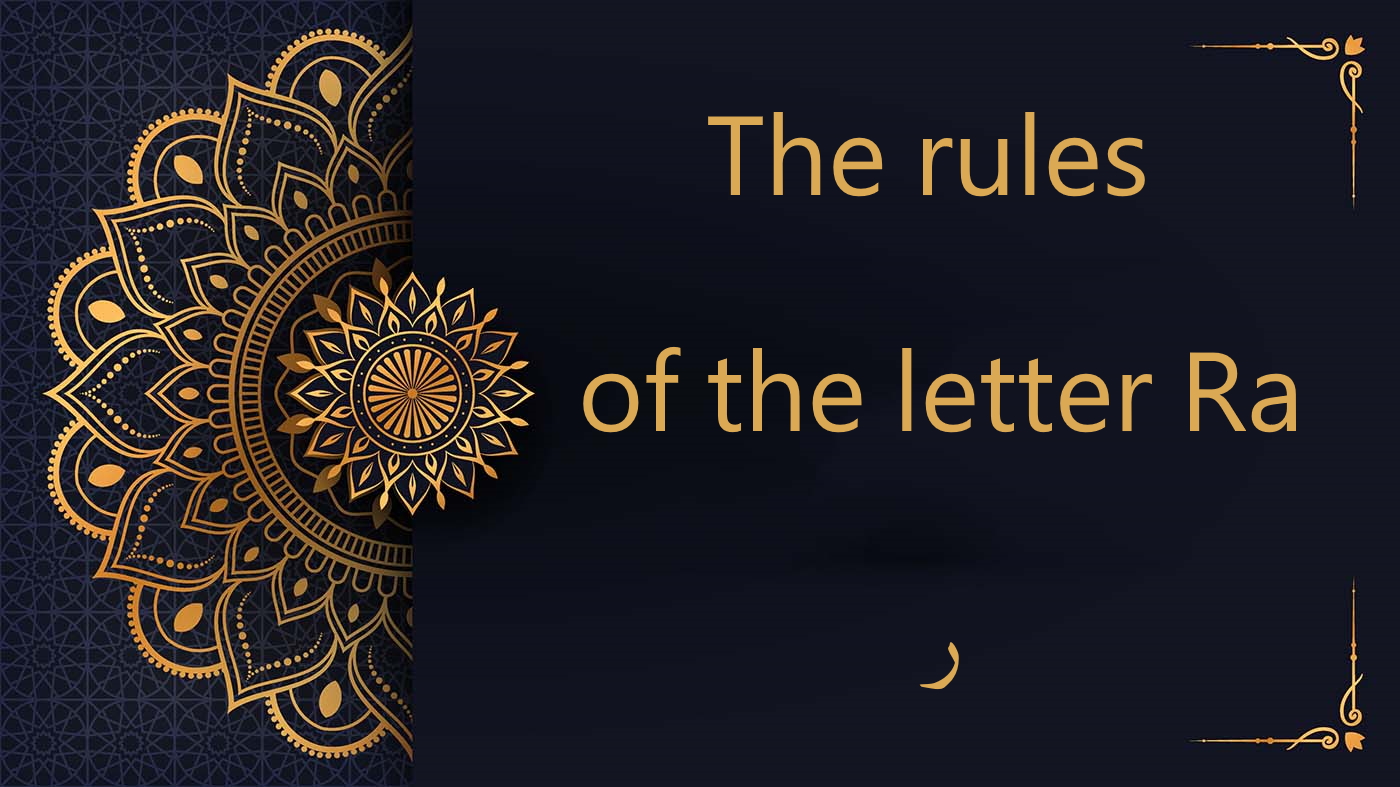
Mastering the Letter Ra ر | Free Tajweed Lesson
Exploring the Nuances of Pronouncing the Arabic Letter “Ra” (ر)
In the realm of Tajweed, the correct pronunciation of the Arabic letter “Ra” (ر) is a fundamental aspect of accurate recitation. When it comes to this letter, there are two distinct ways to pronounce it:
-
Tafkheem (Emphasis): In this pronunciation, you fill your mouth when saying the letter, creating a vertical mouth shape. This technique is called “tafkheem” and involves emphasizing the letter “Ra” to create a bold and pronounced sound.
-
Tarqeeq (Lightness): Conversely, you can read the letter “Ra” lightly, without filling your mouth. This results in a horizontal mouth shape and is referred to as “tarqeeq,” which signifies a more gentle and subtle pronunciation.
When encountering the letter “Ra” (ر) in Arabic words, three possibilities arise, depending on its vocalization or its position within the word:
-
With Tarqeeq: In some instances, the letter “Ra” is read with tarqeeq, signifying a light and gentle pronunciation.
-
With Tafkheem: On the other hand, there are scenarios where you should employ tafkheem, emphasizing the letter “Ra” with a fuller mouth shape, creating a pronounced and bold sound.
-
The Possibility of Both: In certain cases, the letter “Ra” may require a combination of both tarqeeq and tafkheem, depending on the rules of Tajweed and the surrounding context within the word.
Understanding the variations in the pronunciation of “Ra” is essential for precise and melodious Quranic recitation. By mastering these nuances, learners can uphold the beauty and accuracy of the Arabic language while engaging in the sacred act of reciting the Quran.
1. Instances Requiring Gentle Pronunciation: Tarqeeq for the Letter 'Ra' (ر)
A. When the Letter 'Ra' (ر) is Accompanied by a Kasra
In the realm of Arabic phonetics and Tajweed rules, the letter ‘Ra’ (ر) is a vital component. It possesses a unique characteristic that warrants close attention—its interaction with the diacritic mark known as “Kasra.”
When you encounter ‘Ra’ with a Kasra, it signifies a specific phonetic scenario that plays a crucial role in Arabic pronunciation. This combination holds particular significance due to its impact on the sound and articulation of the letter.
The Kasra, represented by a slanted line beneath the letter ‘Ra’ (رِ), serves as a short vowel marker. It indicates that the ‘Ra’ is pronounced with a brief, crisp ‘i’ sound, akin to the ‘i’ in “sit.” This vowel sound is notably distinct from other vowel markers like Fatha or Damma, which impart different qualities to the pronunciation.
The interaction between ‘Ra’ and Kasra at various positions within words contributes to the melody and rhythm of the Arabic language. It influences the flow of spoken Arabic, whether in everyday conversations or in the recitation of the Quran.
Understanding when and how ‘Ra’ pairs with Kasra is crucial for mastering the correct pronunciation and cadence in Arabic. It is an essential component of Tajweed, which enhances the beauty and precision of Quranic recitation while maintaining the integrity of the Arabic language’s phonetic intricacies.
Example:
مِن شَرِّ الْوَسْوَاسِ الْخَنَّاسِ
From the evil of the retreating whisperer (114:4)
B. When the Letter 'Ra' (ر) Bears a Sukoon at the Word's End with a Preceding Kasra
When the letter ‘Ra’ (ر) appears at the end of a word with a sukoon (a diacritic indicating a complete lack of vowel sound), it is accompanied by a kasra, which is a short vowel mark denoted by a slanted line beneath the letter. This specific configuration at the word’s conclusion represents a notable aspect of Arabic phonetics.
In this context, the sukoon signifies that ‘Ra’ is pronounced without any added vowel sound, maintaining a silence or pause. The presence of the kasra before the sukoon ensures that the preceding vowel sound, if any, is a short ‘i’ sound.
This particular phonetic occurrence is integral to precise Arabic pronunciation and contributes to the rhythm and flow of spoken Arabic words. Understanding and correctly applying this sukoon-kasra combination is essential for accurate recitation and a deeper appreciation of the Arabic language’s rich phonological nuances.
Example:
يَا أَيُّهَا الْمُدَّثِّرُ ﴿١﴾ قُمْ فَأَنذِرْ ﴿٢﴾ وَرَبَّكَ فَكَبِّرْ
O you who covers himself [with a garment], Arise and warn, And your Lord glorify (74: 1 to 3)
C. Sukoon Placement in Arabic: 'ر' (Ra) with Original Kasra Preceding 'ه' (Ha) in Mid-Word
In the realm of Arabic phonetics and Tajweed rules, the precise placement of sukoon (a diacritic indicating a complete lack of vowel sound) is a pivotal aspect of accurate pronunciation and Quranic recitation. One particularly intriguing scenario involves the letter ‘ر’ (Ra) when it bears sukoon, occurring precisely in the middle of a word. This unique configuration is characterized by specific conditions:
-
Sukoon on ‘ر’ (Ra): The presence of sukoon atop the letter ‘ر’ denotes that it is to be pronounced without any additional vowel sound.
-
Original Kasra (Short ‘i’ Vowel): Immediately preceding the sukoon, there is an original kasra (a diacritic resembling a slanted line below the letter), indicating a short ‘i’ vowel sound. This kasra serves as the connector between the preceding and succeeding elements in the word.
-
Non-Emphatic Letter ‘ه’ (Ha): Following the sukoon on ‘ر,’ you encounter the non-emphatic letter ‘ه’ (Ha), which is pronounced with a standard or neutral articulation, devoid of any emphasis.
This particular phonetic phenomenon has significant implications for the recitation of Arabic words and the Quran. It not only affects the cadence and rhythm of spoken Arabic but also contributes to the precision and beauty of Quranic recitation. Understanding the interplay of sukoon, kasra, and the non-emphatic ‘ه‘ in mid-word scenarios is crucial for mastering Tajweed rules and achieving eloquent Quranic recitation.
By delving into these intricacies, learners of Arabic can deepen their appreciation of the language’s rich phonological nuances and ensure the accurate and melodious recitation of sacred texts like the Quran.
Example:
فَسَبِّحْ بِحَمْدِ رَبِّكَ وَاسْتَغْفِرْهُ
Then exalt [Him] with praise of your Lord and ask forgiveness of Him. (110:3)
D. The Complex Articulation of 'ر' (Ra) with Sukoon: Preceded by Non-Emphatic Letter with Sukoon Following a Kasra
In the realm of Arabic phonetics and Tajweed, the accurate pronunciation of letters and diacritics is paramount. One intriguing aspect of Arabic phonology involves the letter ‘ر’ (Ra) when it carries sukoon—a diacritic indicating a complete lack of vowel sound. However, this complexity is compounded when ‘ر‘ is preceded by a non-emphatic letter, which also bears sukoon, following a kasra.
Let’s break down this intricate scenario:
-
Sukoon on ‘ر‘ (Ra): When ‘ر‘ is adorned with sukoon, it signifies that the letter is pronounced without any additional vowel sound. This sukoon is essential in preserving the precise pronunciation of ‘ر.’
-
Non-Emphatic Letter with Sukoon: Preceding ‘ر,’ there is a non-emphatic letter that also carries sukoon, denoting a pause or silence in its pronunciation. The nature of this letter is crucial in understanding the overall articulation.
-
Kasra (Short ‘i’ Vowel): The presence of kasra, a diacritic resembling a slanted line below the letter, adds another layer of complexity. Kasra signifies a short ‘i’ vowel sound, which affects the transition between the non-emphatic letter and ‘ر.’
Navigating these intricacies is pivotal for achieving accurate Arabic pronunciation and mastering the art of Quranic recitation. This scenario highlights the precision and richness of the Arabic language’s phonological nuances. Understanding the interplay of sukoon, non-emphatic letters, and kasra is a fundamental aspect of Tajweed, ensuring that the Quran is recited with eloquence, precision, and reverence.
By delving into these complexities, Arabic learners and Quran reciters can deepen their understanding of phonetics and further appreciate the linguistic beauty of this sacred text.
Example:
يُعَلِّمُونَ النَّاسَ السِّحْرَ
teaching people magic(2:102)
2. Emphasizing 'ر' (Ra): When Tafkheem Is Essential
A. When 'ر' (Ra) Bears a Damma
In the realm of Arabic phonetics and pronunciation, the diacritic known as “Damma” holds a significant place. This diacritic, represented as a small curve above the letter, serves to indicate a specific vowel sound. When this diacritic is applied to the letter ‘ر‘ (Ra), it introduces a unique phonetic scenario that is both distinctive and essential to accurate pronunciation.
Let’s break down this scenario:
Damma on ‘ر‘ (Ra): When the letter ‘ر‘ (Ra) carries a Damma, it implies that the letter is pronounced with a specific vowel sound. In this case, the Damma represents a short ‘u’ sound, akin to the ‘u’ in “put.” This vowel sound adds a unique auditory dimension to the pronunciation of ‘ر.’
Understanding when and how ‘ر‘ combines with Damma is crucial for Arabic learners and those studying Tajweed rules. It influences not only the correct articulation of the letter but also contributes to the rhythm and melody of spoken Arabic and Quranic recitation.
By exploring the intricacies of Damma with ‘ر‘ (Ra), learners can enhance their grasp of Arabic phonetics and enrich their ability to recite Arabic texts with precision and eloquence. It’s a nuanced aspect of the language that, when mastered, adds depth and beauty to both spoken and recited Arabic.
Example:
إِذَا جَاءَ نَصْرُ اللَّهِ وَالْفَتْحُ
When the victory of Allah has come and the conquest, (110:1)
B. When 'ر' (Ra) Adopts a Fatha
In the realm of Tajweed, the meticulous science of Quranic recitation, every nuance of pronunciation is carefully considered to honor the sacred text. One such nuance involves the letter ‘ر‘ (Ra) when it adopts a Fatha diacritic.
Here, we will explore this phenomenon in depth:
Fatha on ‘ر‘ (Ra): When the letter ‘ر‘ (Ra) is adorned with a Fatha diacritic, it introduces a specific vowel sound. The Fatha represents a short ‘a’ sound, akin to the ‘a’ in “cat.” This vowel sound is a fundamental component of Arabic phonetics and is essential for the correct enunciation of words in the Quran.
In Tajweed, the precise pronunciation of ‘ر‘ with a Fatha holds profound significance. It allows the reciter to convey the intended meanings of Quranic verses with utmost clarity and reverence. Every vowel sound, including the ‘a’ introduced by the Fatha, contributes to the melodic and rhythmic flow of Quranic recitation, enhancing the overall beauty of the sacred text.
Understanding how ‘ر‘ combines with the Fatha diacritic is an essential aspect of Tajweed. It empowers learners to articulate Arabic words with precision and eloquence, ensuring that the Quran is recited with the utmost respect for its linguistic and phonetic intricacies.
By mastering this dimension of Tajweed, students of the Quran can deepen their connection to the text and communicate its message with reverence and authenticity. This harmonious integration of sound and meaning exemplifies the beauty of Quranic recitation, a practice that continues to inspire and move millions around the world.
Example:
بِسْمِ اللَّهِ الرَّحْمَـٰنِ الرَّحِيمِ
In the name of Allah, the Entirely Merciful, the Especially Merciful. (1:1)
C. When 'ر' (Ra) Bears a Sukoon Preceded by a Damma
Within the intricate world of Arabic phonetics and Tajweed, the correct pronunciation of letters is paramount. One intriguing facet of Arabic phonology is the letter ‘ر‘ (Ra) when it carries sukoon—a diacritic indicating a complete lack of vowel sound—and is preceded by a Damma diacritic.
Let’s dissect this phonetic scenario:
Sukoon on ‘ر‘ (Ra): When ‘ر‘ (Ra) is graced with a sukoon, it implies that the letter is pronounced without any added vowel sound. This sukoon serves as a crucial element in ensuring the precise pronunciation of ‘ر.’
Preceding Damma: The presence of a Damma diacritic—a small curve above the letter that signifies a short ‘u’ vowel sound—before the sukoon on ‘ر‘ introduces a unique phonetic characteristic. This ‘u’ vowel sound subtly influences the transition from the preceding letter to ‘ر.’
Understanding the interaction between sukoon and Damma with ‘ر‘ is pivotal for achieving accurate Arabic pronunciation and mastering the art of Quranic recitation. This scenario highlights the nuanced and rhythmic nature of the Arabic language, as well as its rich phonological subtleties.
By exploring these intricacies, Arabic learners and Quran reciters can gain a deeper appreciation of the language’s phonetics and elevate their ability to recite Arabic texts with precision, fluency, and elegance. It is within these subtleties that the beauty of Arabic phonology truly shines, contributing to the richness of Quranic recitation.
Example:
أُولَـٰئِكَ يُجْزَوْنَ الْغُرْفَةَ بِمَا صَبَرُوا
Those will be awarded the Chamber for what they patiently endured (25:75)
D. When 'ر' (Ra) Bears a Sukoon Preceded by a Fatha
In the realm of Arabic phonetics and Tajweed, where precision in pronunciation is paramount, we encounter the letter ‘ر‘ (Ra) with a distinctive configuration: sukoon (a diacritic indicating a complete lack of vowel sound) preceded by a Fatha diacritic.
Let’s explore the intricacies of this phonetic scenario:
Sukoon on ‘ر‘ (Ra): When ‘ر‘ (Ra) carries a sukoon, it signifies that the letter is pronounced without any additional vowel sound. This sukoon serves as a fundamental component of Arabic phonetics, ensuring the letter is articulated precisely.
Preceding Fatha: The presence of a Fatha diacritic—a small slanted line above the letter that denotes a short ‘a’ vowel sound—before the sukoon on ‘ر‘ introduces a unique phonetic characteristic. This ‘a’ vowel sound affects the transition from the preceding letter to ‘ر,’ contributing to the word’s phonetic flow.
Understanding the interplay between sukoon and Fatha with ‘ر‘ is pivotal for accurate Arabic pronunciation and the mastery of Tajweed rules. This scenario exemplifies the nuanced nature of the Arabic language, where vowel placement and articulation are finely tuned.
By delving into these intricacies, Arabic learners and Quran reciters can elevate their understanding of Arabic phonology and enhance their ability to recite Arabic texts with precision and eloquence. It is within these subtleties that the beauty and richness of Arabic pronunciation come to life, ultimately enhancing the experience of Quranic recitation and the appreciation of the Arabic language.
Example:
وَأَرْسَلَ عَلَيْهِمْ طَيْرًا أَبَابِيلَ
And He sent against them birds in flocks, (105:3)
Within the realm of Tajweed, the science of precise Quranic recitation, intricate rules shape the pronunciation of Arabic letters. One such rule involves the letter ‘ر’ (Ra) when it carries sukoon (a diacritic indicating a complete lack of vowel sound) and is situated within the same word as an original kasra (short ‘i’ vowel) preceding it, followed by an emphatic letter.
Let’s explore this rule in depth:
Sukoon on ‘ر’ (Ra): The presence of sukoon on ‘ر’ signifies that the letter is pronounced without any additional vowel sound. This diacritic ensures the precise articulation of ‘ر.’
Original Kasra (Short ‘i’ Vowel): An original kasra, indicated by a slanted line beneath the letter, appears just before the sukoon on ‘ر.’ This kasra represents a short ‘i’ vowel sound, which is fundamental in Arabic phonetics.
Emphatic Letters: Following the sukoon on ‘ر,’ you encounter emphatic letters, which are characterized by their unique articulation and phonetic properties. These emphatic letters include ظ (Dhāl), خ (Kha), ص (Ṣād), ض (Dāl), غ (Ghain), ط (Ṭā), and ق (Qāf). Emphatic letters are pronounced with added emphasis and are an integral part of Arabic pronunciation.
Within the Holy Quran, there are specific instances where this rule comes into play, totaling five examples. Each example provides an opportunity to demonstrate the precision and beauty of Tajweed, ensuring that the Quran is recited with the utmost reverence and respect for its linguistic and phonetic nuances.
By exploring these intricacies, Quranic learners and reciters can deepen their understanding of the Quran’s recitation rules, allowing them to convey the divine message with accuracy and eloquence. Tajweed, with its delicate rules, adds to the timeless beauty and resonance of the Quran, captivating the hearts and minds of readers and listeners alike.
وَلَوْ نَزَّلْنَا عَلَيْكَ كِتَابًا فِي قِرْطَاسٍ
And even if We had sent down to you, [O Muhammad], a written scripture on a page (6:7)
وَإِرْصَادًا لِّمَنْ حَارَبَ اللَّهَ وَرَسُولَهُ مِن قَبْلُ
and as a station for whoever had warred against Allah and His Messenger before. (9:107)
فَلَوْلَا نَفَرَ مِن كُلِّ فِرْقَةٍ مِّنْهُمْ طَائِفَةٌ لِّيَتَفَقَّهُوا فِي الدِّينِ
For there should separate from every division of them a group [remaining] to obtain understanding in the religion (9:122)
إِنَّ جَهَنَّمَ كَانَتْ مِرْصَادًا
Indeed, Hell has been lying in wait (78:21)
إِنَّ رَبَّكَ لَبِالْمِرْصَادِ
Indeed, your Lord is in observation. (89:14)
E. When 'ر' (Ra) Bears a Sukoon Preceded by a Non-Original Kasra Due to Hamza al-Wasl
Within the realm of Tajweed, the art of Quranic recitation, every nuance in pronunciation holds profound significance. One such nuance involves the letter ‘ر‘ (Ra) when it carries sukoon (a diacritic indicating a complete lack of vowel sound) and is situated in the same word as a non-original kasra, a result of Hamza al-Wasl.
Let’s delve into the intricacies of this scenario:
Sukoon on ‘ر‘ (Ra): The presence of sukoon on ‘ر‘ signifies that the letter is pronounced without any additional vowel sound. This precise articulation of ‘ر‘ is fundamental to Tajweed.
Non-Original Kasra due to Hamza al-Wasl: The non-original kasra, often marked by a slanted line beneath the letter, is a result of Hamza al-Wasl. Hamza al-Wasl is an Arabic linguistic feature, and it introduces this short ‘i’ vowel sound at the beginning of certain words, which is not inherent in the word itself.
Understanding the coexistence of sukoon on ‘ر‘ with a non-original kasra due to Hamza al-Wasl is crucial for achieving correct Quranic pronunciation. This rule exemplifies the meticulous nature of Tajweed, ensuring that every vowel, letter, and diacritic is precisely enunciated.
In the Quran, specific instances present this unique rule, underscoring the importance of studying Tajweed rules for authentic Quranic recitation. By mastering this rule, learners can elevate their Quranic recitation, capturing the eloquence and spiritual essence of the divine text. Tajweed, with its intricate rules, serves as a bridge between the reciter and the profound messages of the Quran, enriching the experience of Quranic study and recitation.
Example:
ارْجِعِي إِلَىٰ رَبِّكِ رَاضِيَةً مَّرْضِيَّةً
Return to your Lord, well-pleased and pleasing [to Him], (89:28)
F. When 'ر' (Ra) Bears a Sukoon at a Pause, Preceded by a Non-Ya Sakeen Letter with Fatha or Damma
In the realm of Tajweed and Quranic recitation, every aspect of pronunciation and articulation is carefully studied to uphold the sanctity and precision of the Quran. One particular rule involves the letter ‘ر‘ (Ra) when it carries sukoon (a diacritic indicating a complete lack of vowel sound) at a pause or stop. This sukoon is often preceded by a non-Ya Sakeen letter and is accompanied by either a Fatha or Damma diacritic.
Let’s explore this rule in more depth:
Sukoon at a Pause on ‘ر‘ (Ra): When ‘ر‘ carries sukoon at a pause or stop, it signifies that the letter is pronounced without any added vowel sound. This is a critical aspect of Tajweed, especially during recitation pauses, to ensure the Quranic text is enunciated accurately.
Preceding Non-Ya Sakeen Letter: The letter before the sukoon on ‘ر‘ is a non-Ya Sakeen letter. This means it is any letter other than ‘ي‘ (Ya) that does not carry any inherent vowel sound.
Accompanied by Fatha or Damma: The presence of either a Fatha (a diacritic resembling a small slanted line above the letter, representing a short ‘a’ sound) or Damma (a diacritic resembling a small ‘u’ shape above the letter, representing a short ‘u’ sound) introduces specific vowel sounds to the pronunciation.
This rule highlights the meticulous nature of Tajweed, ensuring that every pause and pronunciation in the Quran is precise and reverent. It plays a crucial role in maintaining the rhythmic and melodic flow of Quranic recitation, adding depth and beauty to the sacred text.
By mastering this rule, Quranic learners and reciters can deepen their connection with the Quran, ensuring that its recitation is both accurate and imbued with the reverence it deserves. Tajweed, with its intricate rules, is a pathway to the spiritual richness and eloquence of Quranic recitation.
Example:
وَالْعَصْرِ
By the time, (103:1)
3. Variations in Pronunciation: When 'ر' (Ra) Can Be Articulated Lightly or with Emphasis
A. Sukoon on 'ر' (Ra) Preceded by a Kasra-Laden Letter and an Emphatic Letter with Kasra
This Rule Occurs Only Once in the Quran:
فَانفَلَقَ فَكَانَ كُلُّ فِرْقٍ كَالطَّوْدِ الْعَظِيمِ
and it parted, and each portion was like a great towering mountain. (26:63)
If we continue the recitation, a choice emerges between a light (muraqaqa) and an emphatic (mufakhama) pronunciation, both of which are permissible:
-
Emphatic (Tafkheem): The letter ق, being a letter of al isti’la (always emphatic), supports this choice.
-
Light (Tarqeeq): The letter ق is weakened by the presence of a kasra, which favors this option.
However, if you choose to pause at the word فِرْقٍ:
In this scenario, the letter Ra (ر) becomes emphatic. This is because we encounter the specific case in which ‘ر’ carries a sukoon, is preceded by an original kasra within the same word, and is followed by an emphatic letter.
B. If you decide to pause at the word نُذُرِ in Surah al-Qamar, both tafkheem and tarqeeq pronunciations are valid options:
However, it is preferable to opt for tarqeeq over tafkheem in this context. The reason being that the original form of the word is نُذُرِي, and the use of tarqeeq serves as a reminder of the word’s origin.
كَذَّبَتْ عَادٌ فَكَيْفَ كَانَ عَذَابِي وَنُذُرِ
‘Aad denied, and how [severe] were My punishment and warning. (54:18)
C. When pausing at the words يَسْر and أَسْر, both the tarqeeq and tafkheem pronunciations of the letter Ra Sakina (رْ) are permissible.
When we pause on the letter Ra (ر) and it carries a sukoon, it’s important to note that in its original form, it should be followed by a letter ‘ya,’ which has been omitted.
وَاللَّيْلِ إِذَا يَسْرِ
And [by] the night when it passes, (89:4)
D. When the letter ر carries a sukoon due to a pause, it is preceded by an emphatic letter in a non-vocalized state.
Scholars Differ: This Particular Case Occurs Just Four Times in the Holy Quran, Involving Only Two Words:
وَأَسَلْنَا لَهُ عَيْنَ الْقِطْرِ
and We made flow for him a spring of [liquid] copper. (34:12)
قَالَ ادْخُلُوا مِصْرَ إِن شَاءَ اللَّهُ آمِنِينَ
and said, “Enter Egypt, Allah willing, safe [and secure].” (12:99)
The Word مِصْرَ in the Quran: Sura Yunus (Verses 7 and 99) and Sura Zukhruf (Verse 51).
Scholarly Divergence: Approaches to Pronunciation:
In the Quranic context, specifically in the words مِصْرَ found in Sura Yunus (Verses 7 and 99) and Sura Zukhruf (Verse 51), there exists a difference of opinion among scholars regarding pronunciation.
Among these scholars, some advocate for tafkheem (emphatic pronunciation) of the letter ر when stopping at the word مِصْرَ, while others favor tarqeeq (light pronunciation). Notably, Al-Imam Ibn al Jazari has chosen the following approaches:
- Tafkheem (Emphatic Pronunciation) when stopping at the word مِصْرَ.
- Tarqeeq (Light Pronunciation) when stopping at the word قِطْرِ.
Conclusion
This Tajweed rules lesson has concluded. Insha’Allah, the next lesson will cover the rules of the letter Alif ا.
At the Al-dirassa Institute, we provide an accessible path to mastering Tajweed under the guidance of skilled instructors. Should you wish to pursue this further, we warmly invite you to reach out to us.
Chosen and Trusted by Thousands of Satisfied Learners
Discover the experiences of our delighted clients who have thoroughly enjoyed utilizing this standout feature.
Alhamdulillah I‘m very pleased with the arabic and Qur’an lessons I receive from teacher Umm Tasneem and I‘m also content with the al-dirassa administration team who were very quick in answering any questions I had. In a month I progressed a lot and I cannot wait to continue my studies with al-dirassa. May Allah reward everyone at al-dirassa.
 Verified review - view original
Verified review - view original
My Qur’an teacher is fantastic, she teaches me in a loving and kind way where I look forward to the lessons and learn so much. My Arabic teacher is equally as nice and has a lot of patience with me, she has great expertise in the field and I’ve progressed really quickly with her. Thank you Al-dirassa!
 Verified review - view original
Verified review - view original
Book your free trial lesson
Don’t want to go through the translation anymore?
30 free minutes with your qualified Egyptian teacher.




